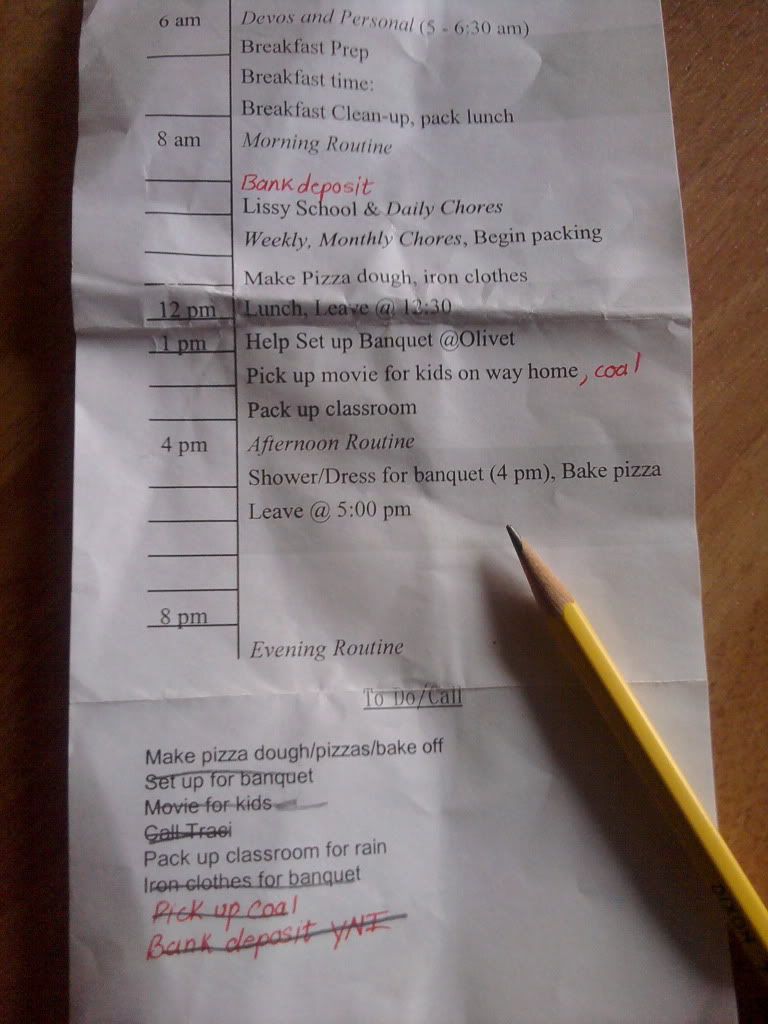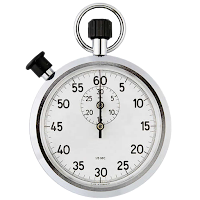We've finally arrived in March, but we still have almost 3 feet of snow in the yard. All of us have cabin fever, and your brothers are fighting influenza this week, too. I think we'll probably take a drive over to Grammy's house tomorrow to water her plants, feed the birds, and clear off snow and ice from the last storm. She's invested many hours of time and energy into our lives it's a pleasure to be able to be a blessing to her.
We've already talked about a weekly plan and keeping focused on the work at hand. It's time to dive into the heart of time management, the daily plan. You will find that you have demands on your time and energy coming from at least a dozen different sources: house, church, school, mail, community groups, family, friends, and the list goes on.
You cannot possibly accomplish everything that is asked of you. You have to make decisions on what to do, and what to leave undone.
God has given you the task of managing your home, and loving your husband and children. That is your top priority. You and your husband must take the time together to decide where you will spend your time and energy. If you decide home education is a priority for your family, for example, that is going to substantially reduce the number of other things you can take on in the church, community, or even for your extended family.
When you say "yes" to one thing, you are automatically saying "no" to something else.
A wise woman carefully considers the not just the value of the additional task she is taking on, but the value of the task(s) that will remain undone, too. She also knows that her heart, longing for acceptance and praise, may gravitate towards doing things that will earn her the praise of others at the expense of her family. A daily plan gives you a concrete tool for deciding whether or not you truly have time to add another item to your to-do list. It also lets you see in black and white what will have to be amended or sacrificed in order to make the additional commitment. It allows you to consider the additional commitment in light of your family's eternal goals.
The tools for a simple, flexible daily plan
A calendar
Whether your family uses Google calendar on your phones, a framed wall calendar, or a Day Planner system, you need a place to write down date-sensitive information.
I choose to enter ONLY appointments and work schedules on our calendars.
Anything that doesn't have to be done on a specific date at a specific time doesn't belong on the calendar.
Routines "She looketh well to the ways of her household."
Routines are simply sets of tasks that have to be done everyday, and are best done by a certain time. These are the lifeblood of home management. If you are transitioning to home after working, it is sometimes difficult to go from a calendar centered life to a routine centered life. Just remember, Hon, progress not perfection!
Too many people make routines into a complicated Everest of tasks carefully printed and placed into elaborately crafted notebooks.
You need two tools to have great routines: time and eyes.
1. Set aside enough time every morning to prepare yourself and your family physically and spiritually for your day.
Have a benchmark in your mind of when you'd like to everyone washed, dressed, fed, and done quiet time. At whatever time you choose, look at yourself and your children. Are you completely dressed with your hair and makeup done? Have you eaten a nutritious breakfast and tidied the kitchen afterwards. Has everyone spent time in the Word and prayer?
This looks different in every family. I despise having everyone hanging around in their jammies with morning routines half done. I have good (and godly) friends who love a relaxed atmosphere and stay in their jammies until after lunch.
2. Set aside enough time every morning, afternoon, and evening to enter each room of your home and make it "company" tidy.
 |
| You can easily see what needs to be done in this room. You don't need a list! |
3. Set aside time every day for weekly and monthly chores.
You took the time to think through your week, make sure you take time to actually implement your plan.
4. Set aside time every day, even if it's only 15 minutes, to maintain your storage areas.
Pick a place that's gotten seedy, and plug away restoring organization in that one spot. Ideally you've already assigned your "stuff" a particular area and used storage containers to make it easy to restore order. If you haven't, now is a great time to begin.
5. Set aside time every day for meal preparation and clean up.
I like to set aside time in the morning to marinate/defrost meats, make salads, and prepare breads and side dishes. I plan 45 minutes for lunch prep/eat/cleanup, and 90 minutes for dinner. We rarely need that much time, so that gives me a few minutes for odd tasks.
Ticker File
This set of 43 manilla files allows you to manage anything that has to be done by a certain date and gives you a home for papers you need on a particular date, like tickets, permission slips, and bills.
Ticklers have been used by administrative assistants for over 100 years and are an extremely powerful tool.
To set one up, label 30 left cut folders from 1 to 30/31. Right cut folders can be turned inside out to create additional left cut folders if necessary. Inside the folder labeled 23, write "Check upcoming month folder."
 |
| This diagram uses left cut for months. I prefer center cut. |
In a 6" open-topped file folder box or a file drawer in your desk, place all of the month folders of the current calendar year starting with NEXT month in front. Place the "Future" folder behind December. You may have several months for the next calendar year which should be placed behind the "Future" folder. This month's folder should be the last folder in your box.
Now place all of the dated folders in the front of the box with tomorrow's date in front. Place any date folders for next month (1 - ?) behind next month's folder. I like to turn Sunday date folders around backwards so I don't accidentally put anything in them.
That's it! Every day, take out that day's folder, empty it, and include the information on your daily plan. File the folder into next month, and re-file any permanent to-do and reminder cards into the next date you'll need them to pop up. On the 23rd of each month you'll empty out the folder for the upcoming month and file the papers into the appropriate date folder.
I'll write you another letter with dozens of ideas for how to use this tool at home because almost everything available is for an office situation.
 Running To-Do List
Running To-Do ListThis is a list of all of the things you simply need to do at some point in the not-too-distant future. It may include calls, purchases, or even research you need to do.
Writing Your Daily Plan
I like to do this on the computer and just print it out, but do whatever feels most comfortable for you. It's ideal to do this the night before, but as long as you get it done first thing in the morning it will still serve you well.
 |
| My to-do list after a day in my pocket. Items in red were tasks Dad asked me to do for him. |
I have 8, 12, and 4 spaced pretty evenly down the left side of my paper.
Write or type in any appointments from your calendar.
Block off any time that you have already scheduled, such as work, school, church, or clubs
Block off times for routines.
On the bottom half of your paper, create a basic to-do/call list
Empty your tickler folder, clipping any papers you need throughout the day to your plan.
Check your running to-do list for any items that will naturally fall into the day's plans or that are getting close to needing to be done.
Look at yesterday's paper and see if there is anything that still needs to be done.
Now pencil your to-do list into time slots on the top half of the paper. When are you actually going to do the items on your "to do" list?
This is an outline of how you anticipate your day going. God may have other plans. Your husband may have other plans. Graciously accept that, and re-schedule or simply leave things undone.
Make a commitment that you won't change your own plans without careful prayer and perhaps a phone call to your husband or an older mentor. The things on your list represent your desire to faithfully serve and bless your family by managing your home well. Changing the timing to accommodate an impromptu trip to the park with friends isn't a big deal. Ditching the whole list to go to the beach for the day may not be the wisest decision. But there are times it will be, and the guidance of the Holy Spirit and your husband are crucial to knowing the difference.
It has been said if you mind the minutes, the hours take care of themselves. I think the same is true of days. If you faithfully manage your home each day, the weeks, months and years care for themselves. You will have far fewer crises, and many more opportunities to bless and serve your family and friends.
I love you to the moon and back,
Mom





This is great post. Love all the tips you provided and I will be putting them into effect here.
ReplyDelete